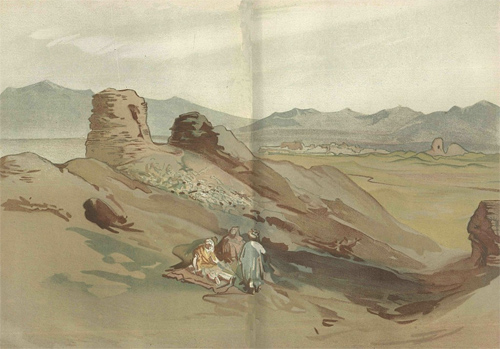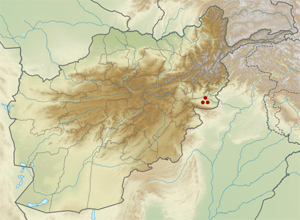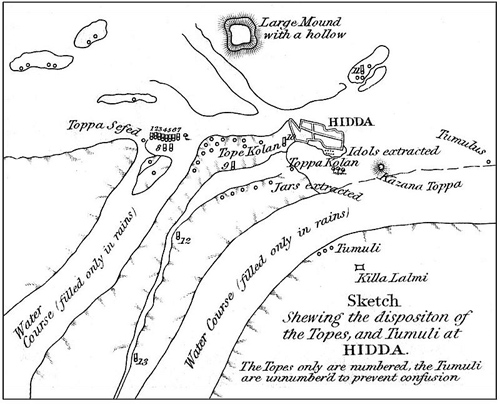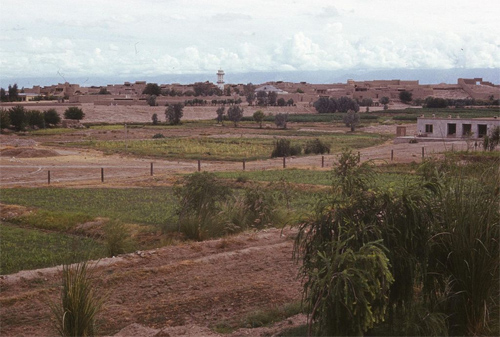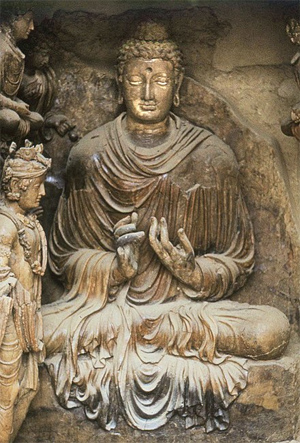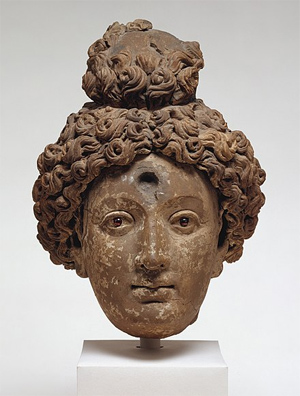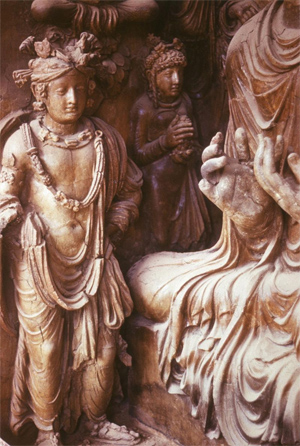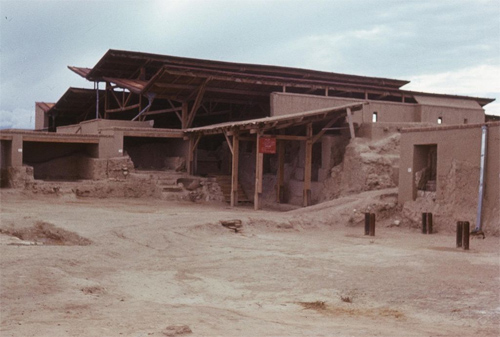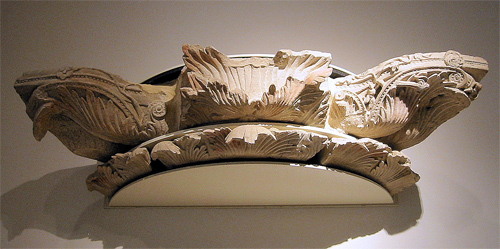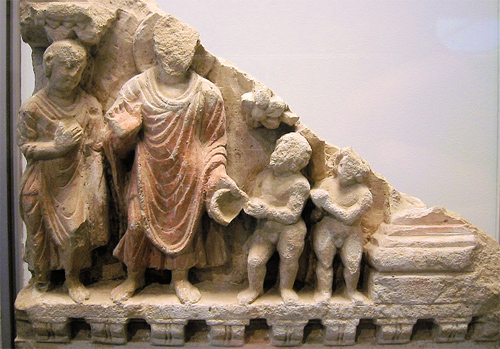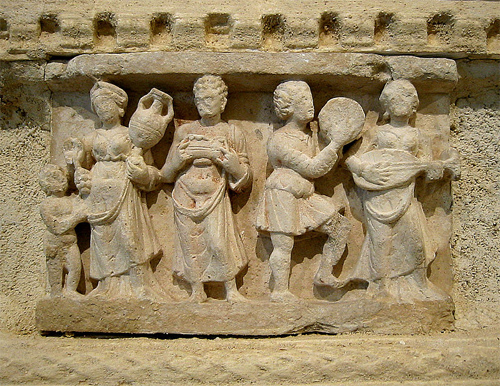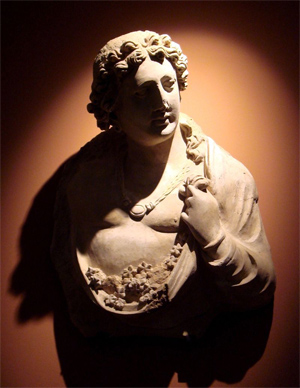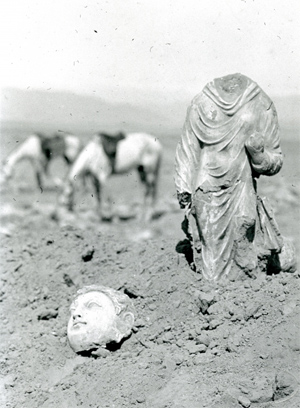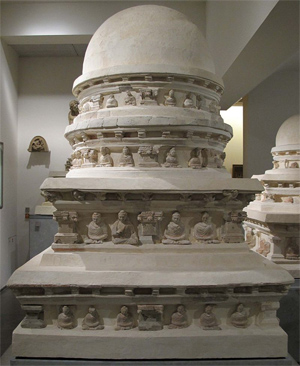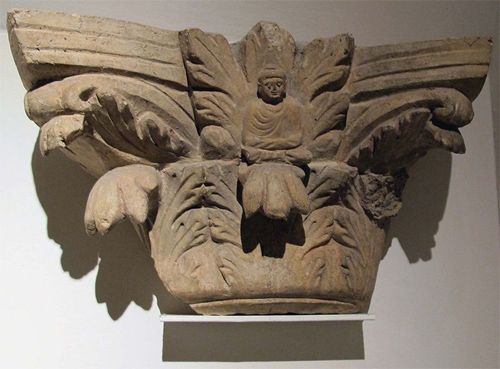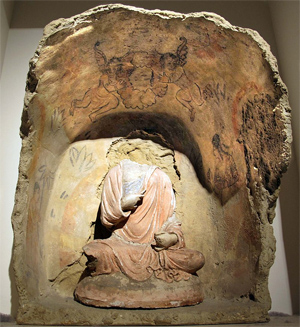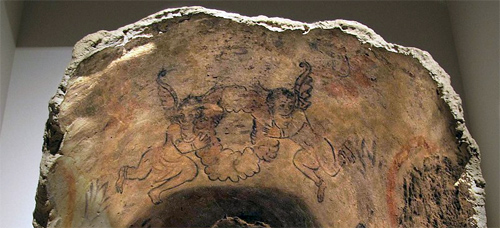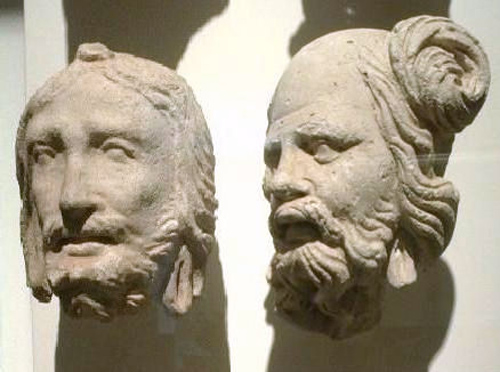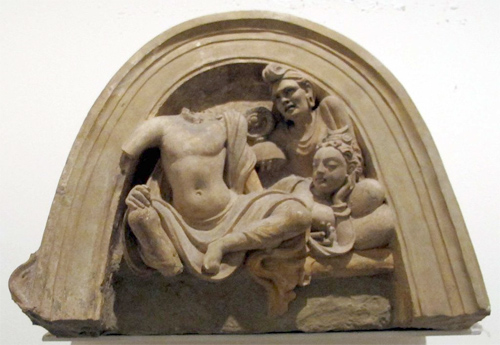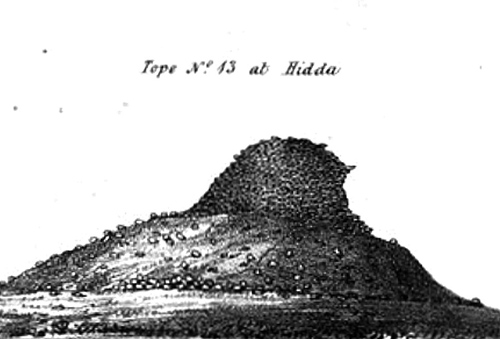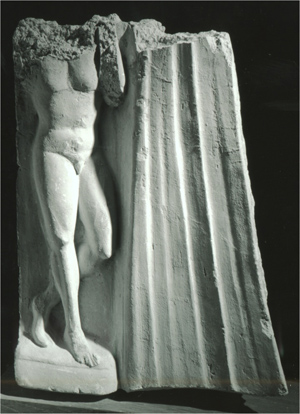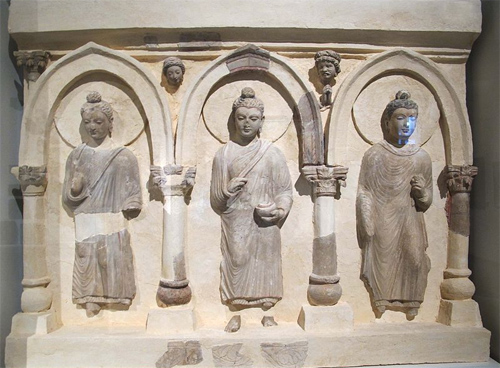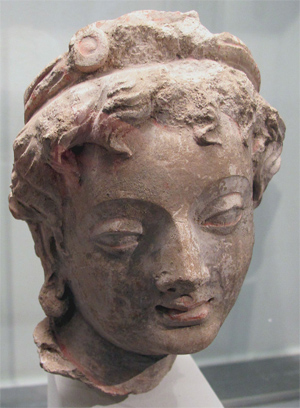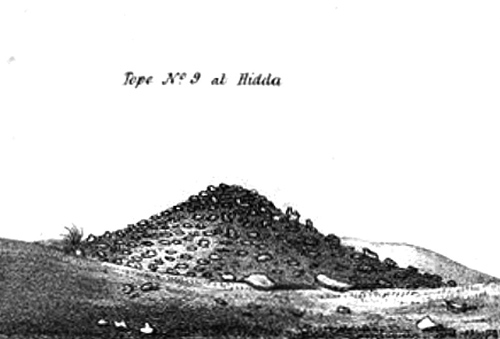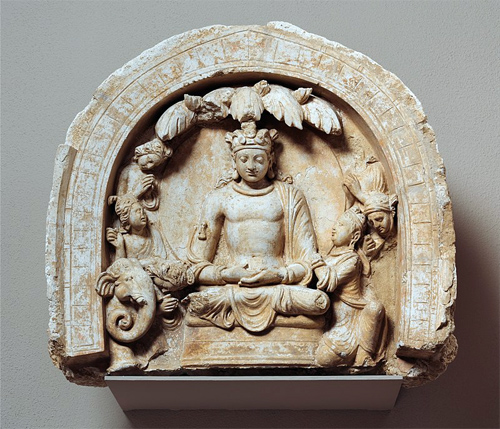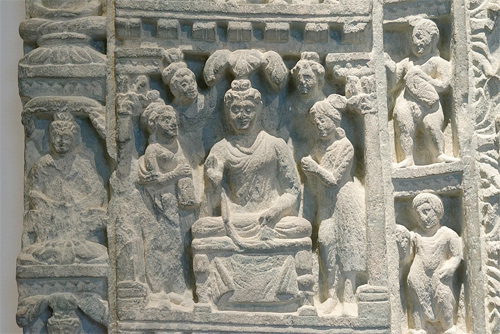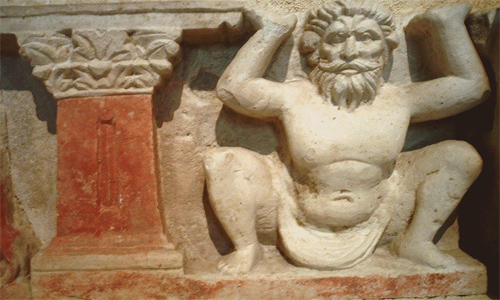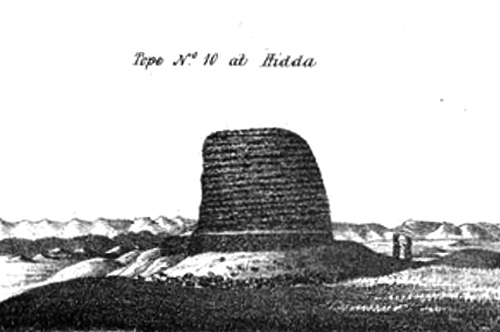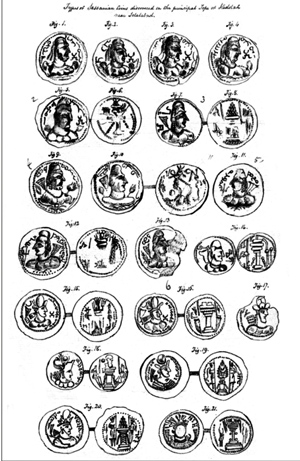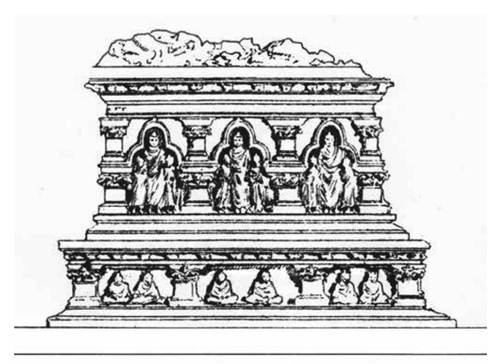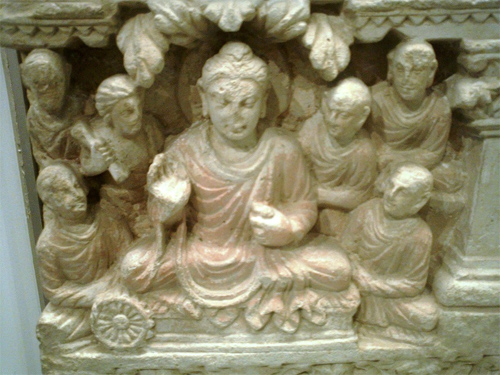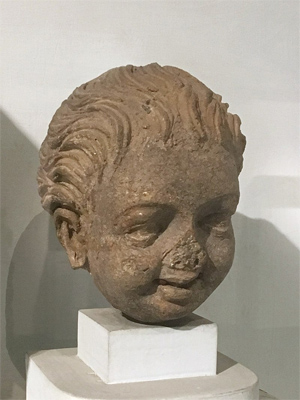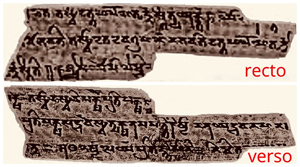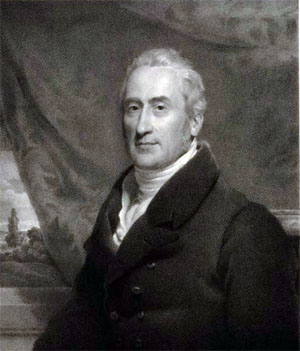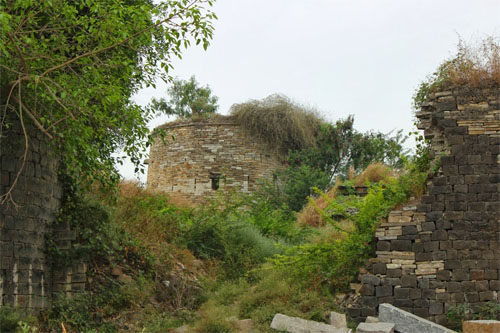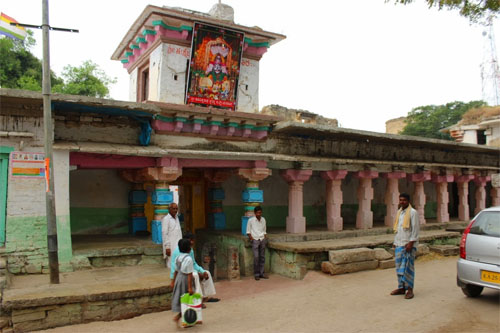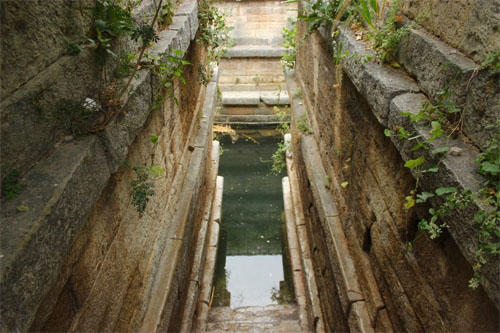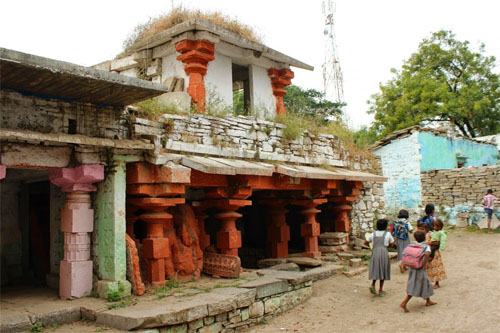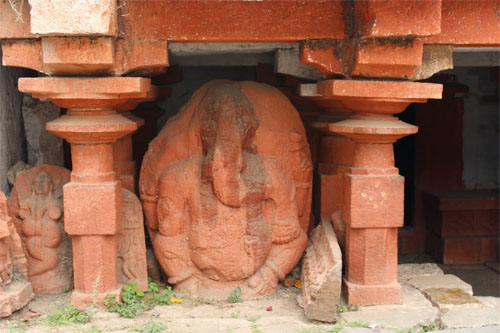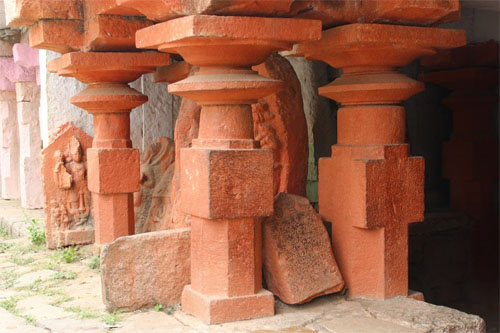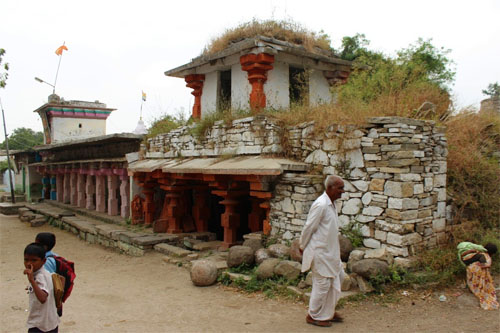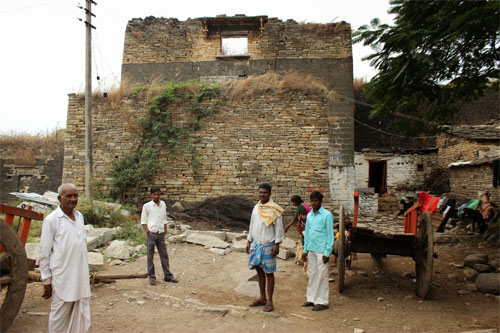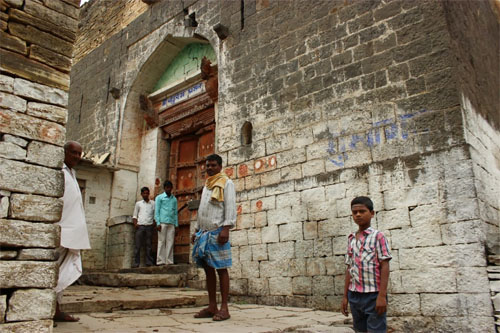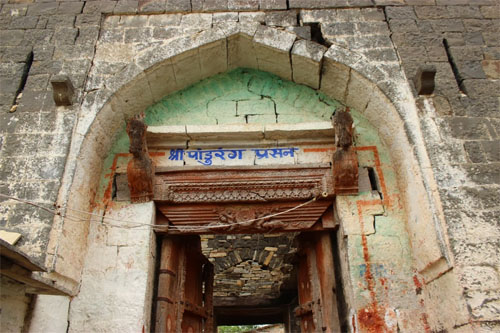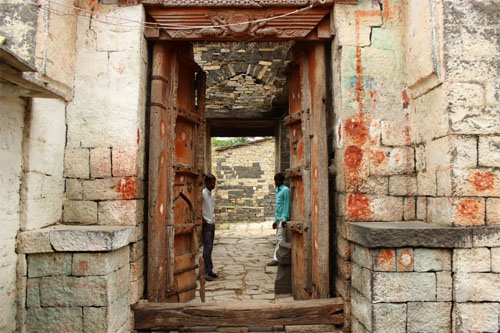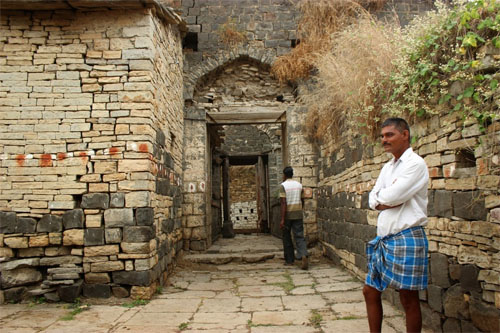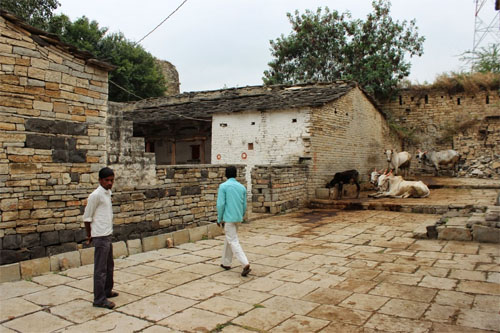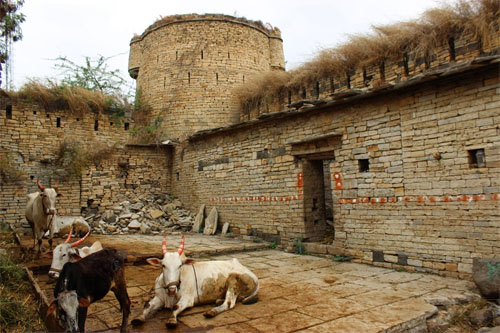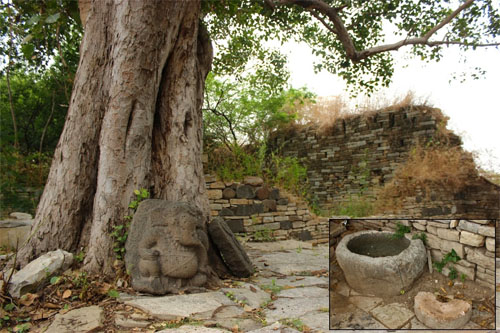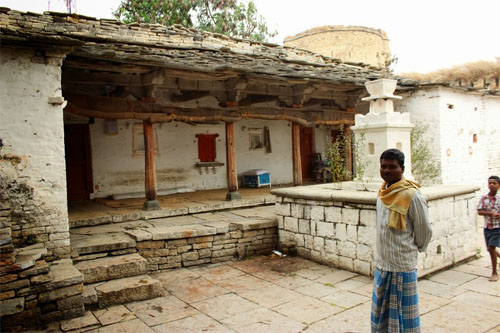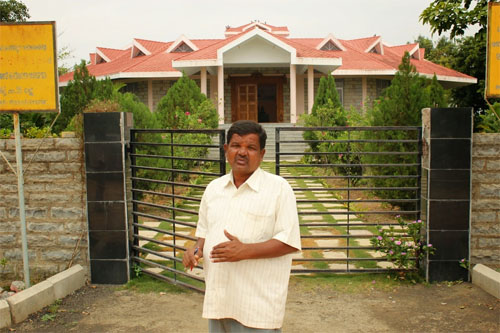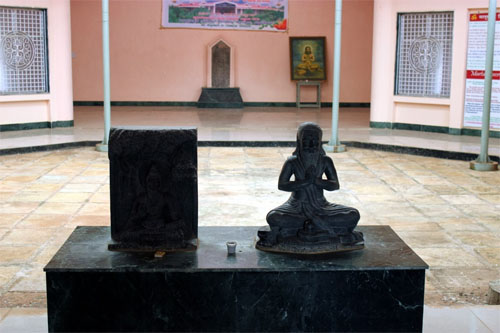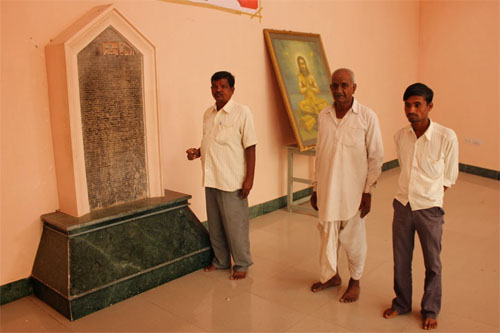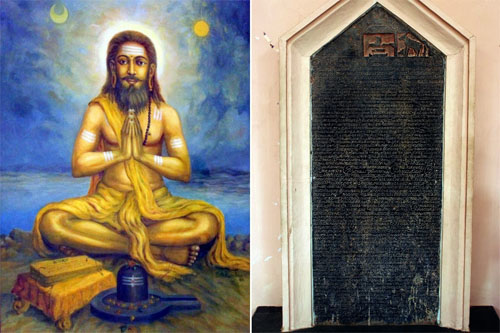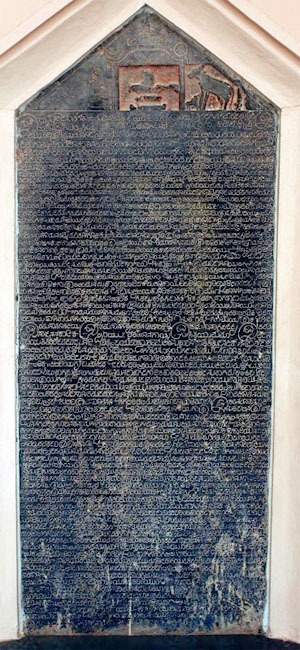 by admin » Thu Jun 03, 2021 10:26 pm
by admin » Thu Jun 03, 2021 10:26 pm
Samgraha, Saṃgraha, Saṃgrāha: 16 definitions
by Wisdom Library
Accessed: 6/3/21
Introduction:
Samgraha means something in Buddhism, Pali, Hinduism, Sanskrit, Jainism, Prakrit, Hindi. If you want to know the exact meaning, history, etymology or English translation of this term then check out the descriptions on this page. Add your comment or reference to a book if you want to contribute to this summary article.
Alternative spellings of this word include Sangrah.
In Hinduism
Natyashastra (theatrics and dramaturgy)
[«previous (S) next»] — Samgraha in Natyashastra glossary
Source: Wisdom Library: Nāṭya-śāstra
Saṃgraha (संग्रह, “propitiation”) refers to ‘winning over’ another person by sweet words and gifts. Saṃgraha represents one of the thirteen garbhasandhi, according to the Nāṭyaśāstra chapter 21. Garbhasandhi refers to the “segments (sandhi) of the development part (garbha)” and represents one of the five segments of the plot (itivṛtta or vastu) of a dramatic composition (nāṭaka).
(Description:) Contact for the use of sweet words and gift, is called Protection (saṃgraha).
Source: archive.org: Natya Shastra
Saṃhraha (संग्रह, “digest”).—When subjects taught in detail have been compressed and brought together in a number of sūtras and their bhāṣyas (commentary), these constitute according to the learned a Digest (saṃhraha).
The Digest (saṃgraha) of the Nāṭyaveda treats
• the sentiments (rasa),
• the Psychological States (bhava),
• the histrionic representation (abhinaya),
• the Practices (dharmī),
• the Styles (vṛtti),
• Local Usages (pravṛtti),
• Success (siddhi),
• the notes (svara),
• the instrumental music (ātodya),
• songs (dhruvā),
• and the stage (raṅga).
context information
Natyashastra (नाट्यशास्त्र, nāṭyaśāstra) refers to both the ancient Indian tradition (śāstra) of performing arts, (nāṭya, e.g., theatrics, drama, dance, music), as well as the name of a Sanskrit work dealing with these subjects. It also teaches the rules for composing dramatic plays (nataka) and poetic works (kavya).
Discover the meaning of samgraha in the context of Natyashastra from relevant books on Exotic India
Vyakarana (Sanskrit grammar)
[«previous (S) next»] — Samgraha in Vyakarana glossary
Source: Wikisource: A dictionary of Sanskrit grammar
Saṃgraha (संग्रह).—Name of a very vast work on grammar attributed to an ancient grammarian Vyadi who is supposed to have been a relative of Panini; cf. सेग्रहेस्तमुपागते (segrahestamupāgate) Bhartrhari's Vakyapadiya cf. also संग्रह-प्रतिकञ्चुकेः (saṃgraha-pratikañcukeḥ) cf. संग्रहो नाम लक्षश्लोकात्मको त्याडिकृतो ग्रन्थः । (saṃgraho nāma lakṣaślokātmako tyāḍikṛto granthaḥ |) Some quotations only are found from the Samgraha in grammar works, but the work is lost long ago.
context information
Vyakarana (व्याकरण, vyākaraṇa) refers to Sanskrit grammar and represents one of the six additional sciences (vedanga) to be studied along with the Vedas. Vyakarana concerns itself with the rules of Sanskrit grammar and linguistic analysis in order to establish the correct context of words and sentences.
Discover the meaning of samgraha in the context of Vyakarana from relevant books on Exotic India
Purana and Itihasa (epic history)
[«previous (S) next»] — Samgraha in Purana glossary
Source: archive.org: Puranic Encyclopedia
Saṃgraha (संग्रह).—One of the two attendants given to Subrahmaṇya by the sea, the other being Vikrama. (Śalya Parva, Chapter 45; Verse 37).
Source: JatLand: List of Mahabharata people and places
Saṃgraha (संग्रह) is a name mentioned in the Mahābhārata (cf. IX.44.46) and represents one of the many proper names used for people and places. Note: The Mahābhārata (mentioning Saṃgraha) is a Sanskrit epic poem consisting of 100,000 ślokas (metrical verses) and is over 2000 years old.
context information
The Purana (पुराण, purāṇas) refers to Sanskrit literature preserving ancient India’s vast cultural history, including historical legends, religious ceremonies, various arts and sciences. The eighteen mahapuranas total over 400,000 shlokas (metrical couplets) and date to at least several centuries BCE.
Discover the meaning of samgraha in the context of Purana from relevant books on Exotic India
Ayurveda (science of life)
[«previous (S) next»] — Samgraha in Ayurveda glossary
Source: gurumukhi.ru: Ayurveda glossary of terms
Saṃgraha (संग्रह):—Restricted movement, Retention, Stiffness
context information
Āyurveda (आयुर्वेद, ayurveda) is a branch of Indian science dealing with medicine, herbalism, taxology, anatomy, surgery, alchemy and related topics. Traditional practice of Āyurveda in ancient India dates back to at least the first millenium BC. Literature is commonly written in Sanskrit using various poetic metres.
Discover the meaning of samgraha in the context of Ayurveda from relevant books on Exotic India
In Buddhism
Mahayana (major branch of Buddhism)
[«previous (S) next»] — Samgraha in Mahayana glossary
Source: Wisdom Library: Maha Prajnaparamita Sastra
Saṃgraha (संग्रह) or “connections” refers to the third book of the Abhidhamma according to the Haimavata school.
context information
Mahayana (महायान, mahāyāna) is a major branch of Buddhism focusing on the path of a Bodhisattva (spiritual aspirants/ enlightened beings). Extant literature is vast and primarely composed in the Sanskrit language. There are many sūtras of which some of the earliest are the various Prajñāpāramitā sūtras.
Discover the meaning of samgraha in the context of Mahayana from relevant books on Exotic India
In Jainism
General definition (in Jainism)
[«previous (S) next»] — Samgraha in Jainism glossary
Source: Encyclopedia of Jainism: Tattvartha Sutra 1
Saṃgraha (संग्रह, “synthetic”) refers to one of the seven types of naya (standpoint), according to the 2nd-century Tattvārthasūtra 1.33.—To cognize an entity by looking at its attributes as primary and secondary depending on the intentions of the speaker or listener is called naya (standpoint/viewpoint).
What is meant by synthetic viewpoint (saṃgraha-naya)? To cognize all the modes of an entity keeping its class (type of substance) in mind, e.g. by saying substance we understand all types of substances.
context information
Jainism is an Indian religion of Dharma whose doctrine revolves around harmlessness (ahimsa) towards every living being. The two major branches (Digambara and Svetambara) of Jainism stimulate self-control (or, shramana, ‘self-reliance’) and spiritual development through a path of peace for the soul to progess to the ultimate goal.
Discover the meaning of samgraha in the context of General definition from relevant books on Exotic India
Languages of India and abroad
Sanskrit dictionary
[«previous (S) next»] — Samgraha in Sanskrit glossary
Source: DDSA: The practical Sanskrit-English dictionary
Saṃgraha (संग्रह).—1 Seizing, grasping; taking; प्रज्वाल्य तत्र चैवाग्निमकरोत् पाणिसंग्रहम् (prajvālya tatra caivāgnimakarot pāṇisaṃgraham) Rām.7.12.2.
2) Clenching the fist, grasp, grip.
3) Reception, admission.
4) Guarding, protection; तथा ग्रामशतानां च कुर्याद्राष्ट्रस्य संग्रहम् (tathā grāmaśatānāṃ ca kuryādrāṣṭrasya saṃgraham) Ms.7.114.
5) Favouring, propitiating, entertaining, supporting; धनैः कार्योऽस्य संग्रहः (dhanaiḥ kāryo'sya saṃgrahaḥ) Ms.3.138;8.311.
6) Storing, accumulation, gathering, collecting; स्वधासंग्रहतत्पराः (svadhāsaṃgrahatatparāḥ) R.1.66; तैः कृतप्रकृतिसंग्रहैः (taiḥ kṛtaprakṛtisaṃgrahaiḥ) 19.55;17.6.
7) Governing, restraining, controlling; एव वै परमो योगो मनसः संग्रहः स्मृतः (eva vai paramo yogo manasaḥ saṃgrahaḥ smṛtaḥ) Bhāg. 11.2.21.
8) Conglomeration.
9) Conjunction.
1) Agglomeration (a kind of saṃyoga).
11) Inclusion, comprehension.
12) Compilation.
13) Epitome, summary, abridgment, compendium; संग्रहेण प्रवक्ष्यन्ते (saṃgraheṇa pravakṣyante) Bg.8.11; so तर्कसंग्रहः (tarkasaṃgrahaḥ); मय्यावेशितया युक्त एतावान् योगसंग्रहः (mayyāveśitayā yukta etāvān yogasaṃgrahaḥ) Bhāg.11.23.61.
14) Sum, amount, totality; करणं कर्म कर्तेति त्रिविधः कर्मसंग्रहः (karaṇaṃ karma karteti trividhaḥ karmasaṃgrahaḥ) Bg.18.18.
13) A catalogue, list.
16) A store-room.
17) An effort, exertion.
18) Mention, reference.
19) Greatness, elevation.
2) Velocity.
21) Name of Śiva.
22) A guardian, ruler, manager; ततो निक्षिप्य काकुत्स्थो लक्ष्मणं द्वारि संग्रहम् (tato nikṣipya kākutstho lakṣmaṇaṃ dvāri saṃgraham) Rām.7.13.15.
23) The fetching back of discharged weapons by magical means; Mb.
24) Taking to wife, marriage.
25) Perception, notion,
Derivable forms: saṃgrahaḥ (संग्रहः).
--- OR ---
Saṃgrāha (संग्राह).—
1) Laying hold of, grasping.
2) Forcible seizure.
3) Clenching the fist.
4) The fist.
5) The handle of a shield.
6) A particular jumping of the horse; Mb.5.155.2. (com. saṃgrāhaḥ bṛhadudraṅgaḥ heṣaṇapūrvakamagra- pādābhyāmutplavanamiti; 'saṃgrāho bṛhadudraṅge' iti viśvaḥ).
Derivable forms: saṃgrāhaḥ (संग्राहः).
Source: Cologne Digital Sanskrit Dictionaries: Edgerton Buddhist Hybrid Sanskrit Dictionary
Saṃgraha (संग्रह).—m., as in Sanskrit, [Boehtlingk and Roth] s.v. 14, das Heranziehen, für sich Gewinnen; freundliche, liebevolle Behandlung; so interpret Lalitavistara 205.8—9 a-saṃgraha-gṛhītasya, afflicted with lack of friendly behavior or disposition; Lalitavistara 426.5 sattva- saṃgrahaprayukta, given to attractive treatment of creatures; Mahāvastu i.107.10 kevarūpeṇa saṃgraheṇa satvā saṃgṛhṇanti, by what sort of attraction do (Bodhisattvas) attract creatures?; compare Mahāvastu i.133.13 saṃgṛhītagrāhiṇaś ca (bodhisattvāḥ), they are characterized by holding those who have been attracted, sc. by the saṃgraha-vastu, as Senart rightly saw, but [Page548-b+ 71] he was wrong in taking saṃgṛhīta as a subst. = saṃgraha; other cases Mahāvastu i.133.17; 163.7. Note especially Gaṇḍavyūha 495.20 samantapāśa-jāla-bhūtaṃ (bodhicittaṃ), sarvavine- yasattva-saṃgraha-karṣaṇatayā, it is…a net…because it draws in by attraction (by kindly behavior) creatures…; compare Lalitavistara 429.13 s.v. saṃgraha-vastu. Sometimes = saṃgraha- vastu, q.v.: Saddharmapuṇḍarīka 142.11 (verse) catvāraḥ saṃgrahā(ḥ).
--- OR ---
Saṃgrāha (संग्राह).—(m.?; the only real Sanskrit literary occurrences are Mahābhārata 5.152.17 susaṃgrāhāḥ [so Crit. ed., for vulgate asaṃ°], under good control, of horses; and one passage in Schmidt, Nachtrāge, = Griff am Messer), seizure, over- whelming (and dangerous) grasp (?): Lalitavistara 374.17 (verse) iha rāgamadana-makaraṃ tṛṣṇormijalaṃ kudṛṣṭi-saṃgrāhaṃ saṃsārasāgaram ahaṃ saṃtīrṇo, I have here crossed the ocean of the saṃsāra, whose sea-monsters are passion and love, whose wave-water is thirst, whose overwhelming grasp is heresy (? both control and attachment seem inappropriate here; I have thought of emending to -saṃgāham, depths, profound abyss, but this is not quotable); neg. a-saṃgrāha, non-grasping, not (wrongly) clinging to, Bodhisattvabhūmi 44.6, 7 asad- bhūta-samāropāsaṃgrāha-vivarjito bhūtāpavādāsaṃgrā- ha-vivarjitaś (Wogihara, Index, renders by Chinese meaning not wrong holding).
Source: Cologne Digital Sanskrit Dictionaries: Benfey Sanskrit-English Dictionary
Saṃgraha (संग्रह).—i. e. sam-grah + a, m. 1. Collection, [Pañcatantra] ii. [distich] 176; conjunction, Bhāṣāp. 133; totality, [Bhagavadgītā, (ed. Schlegel.)] 18, 18. 2. A place where anything is kept. 3. Quantity. 4. A compilation, an abridgment, [Bhagavadgītā, (ed. Schlegel.)] 8, 11. 5. A catalogue. 6. Clenching the fist, clenching, grasp, [Hitopadeśa] iv. [distich] 13. 7. Effort. 8. Restraining, [Lassen, Anthologia Sanskritica.] 2, 1. 9. Governing, [Mānavadharmaśāstra] 7, 113. 10. Protecting, protection, [Mānavadharmaśāstra] 8, 311. 11. Propitiating, attaching, [Pañcatantra] i. [distich] 330 (kurvanti saṃgraham, Attach to themselves); [Rājataraṅgiṇī] 5, 295; encouraging, [Mānavadharmaśāstra] 3, 138. 12. Assent, promise. 13. Taking, seizing, [Rājataraṅgiṇī] 5, 274; mentioning, [Hitopadeśa] ii. [distich] 57. 14. Elevation, loftiness.
--- OR ---
Saṃgrāha (संग्राह).—i. e. sam-grah + a, m. 1. Clenching the fist. 2. The fist. 3. The gripe of a shield. 4. Seizing forcibly.
Source: Cologne Digital Sanskrit Dictionaries: Cappeller Sanskrit-English Dictionary
Saṃgraha (संग्रह).—[masculine] seizing, grasping, laying hold on, keeping, winning, acquiring, taking (also to wife), enjoying, fetching back (of a shot arrow by magic), gathering, assembling, collection; enumeration, sum, totalily; restraining, directing, government, concr. ruler, governor, arranger; short exposition, compendium of (—°); attracting, winning over, kindness.
Source: Cologne Digital Sanskrit Dictionaries: Aufrecht Catalogus Catalogorum
1) Saṃgraha (संग्रह) as mentioned in Aufrecht’s Catalogus Catalogorum:—[grammatical] Quoted in the Preface of the Mahābhāṣya: Saṃgraha etat prādhānyena parīkṣitam. According to Nāgojī this Saṃgraha had Vyāḍi as its author. It seems more natural to attribute the work to Patañjali himself.
2) Saṃgraha (संग्रह):—a grammar, by Lakṣmīdatta. Oudh. X, 8.
3) Saṃgraha (संग्रह):—an abbreviation of Smṛtisaṃgraha q. v.
4) Saṃgraha (संग्रह):—vedānta, by Vīramaheśvarācārya. Rice. 184.
5) Saṃgraha (संग्रह):—med. L. 616. See Aṣṭāṅgasaṃgraha and Aṣṭāṅgahṛdayasaṃgraha.
6) Saṃgraha (संग्रह):—jy. by Gaṇapati. Oudh. Xx, 110. See Jyotiḥsaṃgraha.
Source: Cologne Digital Sanskrit Dictionaries: Monier-Williams Sanskrit-English Dictionary
1) Saṃgraha (संग्रह):—[=saṃ-graha] [from saṃ-grabh] m. holding together, seizing, grasping, taking, reception, obtainment, [Mahābhārata; Kāvya literature] etc.
2) [v.s. ...] taking (in the sense of eating or drinking food, medicine etc.), [Raghuvaṃśa; Bhartṛhari]
3) [v.s. ...] the fetching back of discharged weapons by magical means, [Mahābhārata; Harivaṃśa]
4) [v.s. ...] bringing together, assembling (of men), [Rāmāyaṇa; Raghuvaṃśa; Siṃhāsana-dvātriṃśikā or vikramāditya-caritra, jaina recension]
5) [v.s. ...] collecting, gathering, conglomeration, accumulation (as of stores), [Manu-smṛti; Mahābhārata] etc.
6) [v.s. ...] (in [philosophy]) agglomeration (= saṃyoga q.v.), [Monier-Williams’ Sanskrit-English Dictionary]
7) [v.s. ...] a place where anything is kept, a store-room, receptacle, [Bhāgavata-purāṇa]
8) [v.s. ...] complete enumeration or collection, sum, amount, totality (eṇa, ‘completely’, ‘entirely’), [Yājñavalkya; Mahābhārata] etc.
9) [v.s. ...] drawing together, making narrower, narrowing, tightening, making thin or slender, the thin part of anything, [Caraka; Vāgbhaṭālaṃkāra; Kātyāyana-śrauta-sūtra [Scholiast or Commentator]]
10) [v.s. ...] a compendium, summary, catalogue, list, epitome, abridgment, short statement (eṇa or āt, ‘shortly’, ‘summarily’, ‘in few words’), [Kaṭha-upaniṣad; Mahābhārata] etc.
11) [v.s. ...] inclusion, comprehension, [Kusumāñjali; Manvarthamuktāvalī, kullūka bhaṭṭa’s Commentary on manu-smṛti]
12) [v.s. ...] check, restraint, control, [ib.; Vetāla-pañcaviṃśatikā]
13) [v.s. ...] keeping, guarding, protection, [Manu-smṛti; Mahābhārata] etc.
14) [v.s. ...] a guardian, ruler, manager, arranger, [Rāmāyaṇa; Bhāgavata-purāṇa]
15) [v.s. ...] obstruction, constipation (See -grahanī)
16) [v.s. ...] attracting, winning, favouring, kind treatment, propitiation, entertaining, entertainment, [Manu-smṛti; Mahābhārata] etc.
17) [v.s. ...] taking to wife, marriage (See dāra-s)
18) [v.s. ...] perception, notion, [Kapila; Bhāgavata-purāṇa]
19) [v.s. ...] mention, mentioning, [cf. Lexicographers, esp. such as amarasiṃha, halāyudha, hemacandra, etc.]
20) [v.s. ...] elevation, loftiness, [cf. Lexicographers, esp. such as amarasiṃha, halāyudha, hemacandra, etc.]
21) [v.s. ...] velocity, [cf. Lexicographers, esp. such as amarasiṃha, halāyudha, hemacandra, etc.]
22) [v.s. ...] Name of Śiva, [Mahābhārata]
23) [v.s. ...] Name of various works ([especially] of a gram. [work] in 100,000 Ślokas by Vyāḍi; also often in [compound])
24) Saṃgrāha (संग्राह):—[=saṃ-grāha] [from saṃ-grabh] m. grasping, laying hold of, forcible seizure, [Horace H. Wilson]
25) [v.s. ...] the fist or clenching the fist, [cf. Lexicographers, esp. such as amarasiṃha, halāyudha, hemacandra, etc.] (cf. [Pāṇini 3-3, 36 [Scholiast or Commentator]])
26) [v.s. ...] the handle of a shield, [cf. Lexicographers, esp. such as amarasiṃha, halāyudha, hemacandra, etc.]
[Sanskrit to German] (Deutsch Wörterbuch)
Source: Cologne Digital Sanskrit Dictionaries: Böhtlingk and Roth Grosses Petersburger Wörterbuch
Saṃgraha (संग्रह):—(von grah = grabh mit sam) m.
1) das Ergreifen: karkaṭa (besser karkaṭakagraha) [Spr. (II) 4523, v. l.] āyudha [7218.] kṛtakāṣāya adj. so v. a. das Anlegen [Rājataraṅgiṇī 3, 320.] das für sich Nehmen, Behalten: pradānaṃ ca pradeyānāmadeyānāṃ ca saṃgrahaḥ [KĀM. NĪTIS. 13, 52.] [Rājataraṅgiṇī 5, 174. fg.] das Bekommen, Erhalten: gṛhasaṃgrahatatparāḥ [Harivaṃśa 6503.] das zu sich Nehmen, Geniessen: svadhā [Raghuvaṃśa 1, 66.] bheṣaja [Spr. (II) 6348] [?(pl., v. l. sg.).] —
2) das (auf übernaturliche Weise geschehende) Zurückholen eines abgeschossenen Pfeiles u.s.w. [Mahābhārata 10, 692.] [Rāmāyaṇa 6, 69, 32.] die darüber handelnde Lehre (in ähnlicher Verbindung aber in anderer Bed. [Weber’s Indische Studien 1, 21, 13]) [Mahābhārata 9, 2471.] [Harivaṃśa 4910]; vgl. saṃhāra . —
3) das Beisammenlassen: ubhayahetu [Prātiśākhya zum Ṛgveda 11, 2. 23.] —
4) das Zusammenbringen, Sammeln, Aufspeichern, Anhäufen; Vorrath: arthasya [Manu’s Gesetzbuch 9, 11.] sasyādeḥ [KĀM. NĪTIS. 12, 18.] [Raghuvaṃśa 17, 60.] [Spr. (II) 1303, v. l. 2183. 2209. 2595. 2742, v. l. 3144. 5087. 6676.] [Varāhamihira’s Bṛhajjātaka S. 40, 14. 42, 3. 4.] [Rājataraṅgiṇī 6, 70.] [Hitopadeśa 91, 2.] [Vetālapañcaviṃśati] in [Lassen’s Anthologie (III) 15, 8.] [Scholiast] zu [Pāṇini’s acht Bücher 3, 3, 36.] subhāṣitamayairdravyaiḥ saṃgrahaṃ na karoti yaḥ [Spr. (II) 7114.] rasadhānyedhma Vorrath von [6239.] dharma [Mahābhārata 5, 7146.] [Spr. (II) 292. 3675. 4250.] dharmārtha [Rāmāyaṇa 4, 28, 1. 5, 51, 14.] cāritra [7, 13, 18.] guṇa [Bhāgavatapurāṇa 4, 20, 26.] das Versammeln, Zusammenbringen (von Menschen): dikṣu sarvāsu sainyānāṃ sarveṣāṃ kuru saṃgraham [Rāmāyaṇa 4, 28, 30.] balānām [5, 72, 20.] kṛtaprakṛtimukhya adj. [Raghuvaṃśa 19, 55.] —
5) Zusammenstellung, vollständige Aufzählung: asthi [Yājñavalkya’s Gesetzbuch 3, 90.] parva [Mahābhārata 1, 311.] nāma [?13, 1114. Suśruta 1, 150, 3. DAŚAR. 1, 39. Sāhityadarpana 389. Spr. (II) 2913, v. l.] pāda im dhanurveda [Weber’s Indische Studien 1, 21, 13.] [Siddhāntakaumudī] zu [Pāṇini’s acht Bücher 7, 2, 63.] uktānāmapyanuktānāṃ śabdānāmiha saṃgrahaḥ [Halāyudha 5, 61.] nānārthasaṃgrahaṃ kar [Trikāṇḍaśeṣa 3, 3, 1. 5, 1.] Sammlung: kathā [Lassen’s Anthologie (III) 32, 4.] [Hitopadeśa] in den Unterschrr. der Bücher. Gesammtheit, Inbegriff, das Ganze [Bhāṣāpariccheda 155.] karaṇaṃ karma karteti trividhaḥ karmasaṃgrahaḥ [Bhagavadgītā 18, 18.] indriya [KĀM. NĪTIS. 1, 31.] [Bhāgavatapurāṇa 4, 28, 57.] [Rāmāyaṇa 5, 42, 3. 4.] [Varāhamihira’s Bṛhajjātaka 12, 9. 28 (26), 6.] suratotsava [Mṛcchakaṭikā 87, 6.] artha = kośa [Halāyudha 5, 54.] loka [Viṣṇupurāṇa 1, 2, 56.] kāla (ed. Bomb. paryaye) die ganze Zeit so v. a. Termin [Rāmāyaṇa 4, 31, 8.] saṃgraheṇa vollständig [Rāmāyaṇa] [SCHL. 2, 56, 25.] ein vollständiges Compendium und Titel von solchen Compendien (insbes. eines grossen grammatischen Werkes des Vyāḍi) [Trikāṇḍaśeṣa 3, 2, 24.] gaṇa kathādi zu [Pāṇini’s acht Bücher 4, 4, 102.] sarve vedāḥ sopavedopaniṣadaḥ sarahasyāḥ sasaṃgrahāḥ [Mahābhārata.8,4414.] [Oxforder Handschriften 12,a,28.] (grantham) sasūtravṛttyarthapadaṃ mahārthaṃ sasaṃgraham (Vyāḍi’s Werk nach dem Comm.) [Rāmāyaṇa 7, 36, 45.] kratusaṃgrahapariśiṣṭa [Weber’s Indische Studien 1, 59. 5, 42. 127. 159. fgg.] sarvaśākuna [Varāhamihira’s Bṛhajjātaka S. 86, 4.] vṛtta [104, 64.] sasaṃgrahaṃ vyākaraṇamadhīte [Pāṇini’s acht Bücher.6,3,79, Scholiast] [Oxforder Handschriften 279,b,34. 292,a,12] (gṛhya). kāra [?271,a,9. 10. 274,a, No. 649. Notices of Skt Mss.2,57. Colebrooke.1,234. 300.] Vgl. 11). —
6) das Umfassen, Einschliessen, Mitbegreifen: uttamagrahaṇamupāntyasyāpi saṃgrahārtham [Scholiast] zu [Pāṇini’s acht Bücher 5, 4, 90.] [KUSUM. 24, 3. 53, 4.] [Kullūka] zu [Manu’s Gesetzbuch 3, 117.] —
7) was Etwas umfasst, einschliesst; Behälter [Bhāgavatapurāṇa 3, 8, 25. 4, 17, 30. 21, 34. 24, 45.] —
8) das im Zaum Halten: manasaḥ [Bhāgavatapurāṇa 11, 20, 21.] duṣṭānām (Gegens. pālana) [Vetālapañcaviṃśati] in [Lassen’s Anthologie (III) 1, 19.] —
9) das in Ordnung Halten, Bewahren, Hüten: rāṣṭrasya [Manu’s Gesetzbuch 7, 113. fg.] [Mahābhārata 12, 3261.] der Welt im Gegens. zu nigraha [Bhāgavatapurāṇa 7, 2, 39.] —
10) Lenker, Regierer, Behüter: sarvalokāmarayajña [Bhāgavatapurāṇa 4, 14, 21.] sarva [Rāmāyaṇa 1, 6, 1.] tato nikṣipya kākutstho lakṣmaṇaṃ dvāri saṃgraham etwa Verfüger, Anordner [7, 103, 15.] = samyaguktārthagrahaṇavantam Comm.; eher saṃgrahe in der Bed.
14) zu lesen. —
11) Zusammendrängung, kurze Darlegung [Mārkāṇḍeyapurāṇa 53, 9] (wohl utpattisaṃgrahaṃ zu lesen). saṃgraheṇa in Kürze, mit kurzen Worten [Kaṭhopaniṣad 2, 15.] [Bhagavadgītā 8, 11.] [Spr. (II) 3253.] [Bhāgavatapurāṇa 4, 8, 5.] saṃgrahāt dass. [Mahābhārata 6, 178. 13, 2630. fg.] [SARVADARŚANAS. 53, 21.] arhatpravacanasaṃgrahapara [31, 14.] saṃgrahe pravṛttā vayam [41, 5. 97, 8.] ślokāḥ [108, 5] (saṃgraha als Titel eines Werkes gefasst von [HALL 164]). rāddhānta [127, 13. fg.] [Bhāgavatapurāṇa 2, 7, 51. 11, 23, 60.] madīye laghusaṃgrahe [Oxforder Handschriften 252,b, No. 626.] bhūtārtha [Spr. (II) 3593.] śiraśchetsyāmi vai karadānasya saṃgraham (vgl. karasaṃkṣepa [15802]) so v. a. kurze Antwort auf [Harivaṃśa 15800.] iti madvacanādrāmo vaktavyo mama saṃgraham (so lesen wir st. saṃgrahaḥ) [Rāmāyaṇa 7, 48, 18.] Vgl. 5). —
12) Verengerung. Schmälerung; schmale Stelle: vāraṅgasya [VĀGBH. 1, 25, 13.] [Scholiast] zu [Kātyāyana’s Śrautasūtrāṇi 688, 17.] madhya [217, 23.] —
13) Verstopfung; s. grahaṇī . —
14) das Heranziehen, für sich Gewinnen; freundliche —, liebevolle Behandlung: sāmadānārthasaṃyuktaḥ saṃgrahaḥ parikīrtitaḥ [Bharata] [NĀṬYAŚ. 19,84. 63. 34,85.] [DAŚAR.1,37.] [Sāhityadarpana 370.] [PRATĀPAR. 37,a,1.] dhanaiḥ kāryo sya (mitrasya) saṃgrahaḥ [Manu’s Gesetzbuch 3, 138.] sādhūnām [8, 311] (Gegens. nigraha). mitra [Spr. (II) 1959. 2261. 2916.] [Mahābhārata 1, 5620] (Gegens. vigraha). [5, 968] (Gegens. nigraha). [?13, 4313. Rāmāyaṇa 2, 98, 6. Rāmāyaṇa Gorresio 1, 4, 69. 4, 28, 10. 5, 90, 12. fg. KĀM. NĪTIS. 3, 39. 13, 74. 19, 2. Spr. (II) 1447. 3204. Rājataraṅgiṇī 5, 295. Hitopadeśa 92, 17, v. l. Bhāgavatapurāṇa 10, 84, 15.] —
15) das zur Ehe Nehmen, Heirathen: citrāṅgadā [Mahābhārata 1, 125] in der Unterschr. des Adhyāya. —
16) Auffassung, Wahrnehmung: sparśasya [Bhāgavatapurāṇa 3, 26, 35.] das Verstehen: ayauktikasya [Kapila 1, 26.] satsaṃgraha adj. der von Guten verstanden wird [Bhāgavatapurāṇa 6. 9, 44.] su etwa leicht zu fassen [Harivaṃśa 11573.] — Die indischen Lexicographen kennen folgende Bedd.: graha [Medinīkoṣa Hemacandra’s Abhidhānacintāmaṇi 25.] grāha (st. vigraho ist saṃgraho zu lesen) [Hemacandra’s Anekārthasaṃgraha 3, 770.] samāhṛti [Amarakoṣa 1, 1, 5, 7.] [Hemacandra’s Abhidhānacintāmaṇi 257.] saṃkṣepa [Trikāṇḍaśeṣa 3, 3, 461.] [Hemacandra’s Abhidhānacintāmaṇi 1432.] [Hemacandra’s Anekārthasaṃgraha] [Medinīkoṣa] [Halāyudha 4, 81.] bṛhaduddhāra [Hemacandra’s Anekārthasaṃgraha] bṛhadudraṅga (statt dessen bṛhat und uttuṅga [Śabdakalpadruma] nach ders. Aut.; vgl. unter saṃgrāha) [Medinīkoṣa] muṣṭi [VIŚVA im Śabdakalpadruma] svīkāra, mahadyoga [NĀNĀRTHARATNAM.] ebend. — Vgl. anekārtha, tarka, dāra (auch [Mahābhārata 1, 1045. 13, 6087.] [Rāmāyaṇa 2, 37, 23.] [Kathāsaritsāgara 24, 152]), dravyasāra, dhanaṃjaya (unter dhanaṃjaya
2) h) in den Nachträgen), dharma (s. auch oben u. 4), nānārtha (unter nānārtha 3), nāma, nyāya, pāṇi (auch [Rāmāyaṇa Gorresio 1, 75, 21] und zwar bei der Verlobung), putra, bindu, bhagavannāmamāhātmyagrantha, bhāratasaṃgrahadīpikā, bhāvanāsāra, yoga, yogavṛtti, ratna, loka (in der 2ten Bed. auch [Bhagavadgītā 3, 20.] [Spr. (II) 3735, v. l.] Gesammtheit der Welten [Viṣṇupurāṇa 1, 2, 56]), vāstu, vṛtti, vaidya, vaidyakasāra, vrata, śāstrasiddhāntaleśa, sāra, smṛti, smṛtisāgara und sāṃgrahika .
--- OR ---
Saṃgrāha (संग्राह):—(von grah = grabh mit sam) m. = muṣṭi (nach dem [Scholiast] zu [Pāṇini’s acht Bücher] Faust, nicht Griff: aho mallasya saṃgrāhaḥ) [Pāṇini’s acht Bücher 3, 3, 36] (vgl. [6, 2, 144]). Faust [Amarakoṣa 3, 3, 14] (= muṣṭibandha das Ballen der Faust). [Hemacandra’s Abhidhānacintāmaṇi 597.] [Halāyudha 2, 368.] Griff eines Schildes [Amarakoṣa 2, 8, 2, 58.] [Hemacandra’s Abhidhānacintāmaṇi 784.] Zu belegen ist nur asaṃgrāha adj. als Beiwort gut gearteter Pferde [Mahābhārata 5, 5262.] nach [Nīlakaṇṭha] sich nicht bäumend: saṃgrāhaḥ bṛhadudraṃgaḥ (vgl. unter saṃgraha am Ende) heṣaṇapūrvakamagrapādābhyāmutplavanamiti yāvat tadrahitāḥ asaṃgrāhāḥ saṃgrāhāḥ saṃgrāho bṛhaduraṃga iti viśvaḥ .
context information
Sanskrit, also spelled संस्कृतम् (saṃskṛtam), is an ancient language of India commonly seen as the grandmother of the Indo-European language family (even English!). Closely allied with Prakrit and Pali, Sanskrit is more exhaustive in both grammar and terms and has the most extensive collection of literature in the world, greatly surpassing its sister-languages Greek and Latin.
Discover the meaning of samgraha in the context of Sanskrit from relevant books on Exotic India
Hindi dictionary
[«previous (S) next»] — Samgraha in Hindi glossary
Source: DDSA: A practical Hindi-English dictionary
Saṃgraha (संग्रह) [Also spelled sangrah]:—(nm) collection; compilation; compendium; repository, deposit, storage; reserve; ~[karttā] compiler, one who collects/stores/compiles.
context information
...
Discover the meaning of samgraha in the context of Hindi from relevant books on Exotic India
See also (Relevant definitions)
Partial matches: Graha, Sam.
Starts with (+11): Samgrahacudamani, Samgrahagrahani, Samgrahagrahya, Samgrahagrantha, Samgrahaka, Samgrahakara, Samgrahakarika, Samgrahalaya, Samgrahana, Samgrahaneshti, Samgrahani, Samgrahanihara, Samgrahanikapata, Samgrahaniratna, Samgrahanisutra, Samgrahaniya, Samgrahaparvan, Samgrahaprakashika, Samgraharamayana, Samgraharatnamala.
Ends with (+558): Acarasamgraha, Adbhutasamgraha, Adbhutasarasamgraha, Adhikaranarthasamgraha, Adhikarasamgraha, Adidharmasarasamgraha, Advaitabrahmasiddhiviniyogasamgraha, Advaitamakarandasamgraha, Advaitanirnayasamgraha, Advaitasamgraha, Advaitavaidikasiddhantasamgraha, Agamasarasamgraha, Agamatattvasamgraha, Aghasamgraha, Ahnikasmritisamgraha, Aitareyopanishatkhandarthasamgraha, Alamkarasamgraha, Alamkarashastrasamgraha, Amshumadbhedasamgraha, Anadivirashaivasamgraha.
Full-text (+2859): Asamgraha, Mushtisamgrahapidita, Gudakesa, Samgrahakara, Samgrahavastu, Samgrahagrantha, Samgrahaprakashika, Samgraharamayana, Samgrahacudamani, Samgrahavaidyanathiya, Samgraharatnamala, Samgrahavivarana, Samgrahagrahani, Samgrahavat, Samgrahashloka, Samgrahaparvan, Samgrahita, Samgrahaka, Kushalasamgraha, Dhanyasamgraha.
